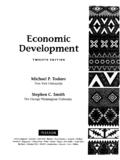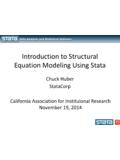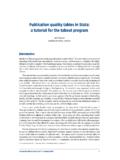Transcription of Microeconometrics Using Stata - GBV
1 Microeconometrics Using Stata A. COLIN CAMERON. Department of Economics University of California Davis, CA. PRAVIN K. TRIVEDI. Department of Economics Indiana University Bloomington, IN. A Stata Press Publication StataCorp LP. College Station, Texas Contents List of tables xxxv List of figures xxxvii Preface xxxix Stata basics 1. Interactive use 1. Documentation 2. Stata manuals 2. Additional Stata resources 3. The help command 3. The search, findit, and hsearch commands 4. Command syntax and operators 5. Basic command syntax 5. Example: The summarize command 6. Example: The regress command 7.
2 Abbreviations, case sensitivity, and wildcards 9. Arithmetic, relational, and logical operators 9. Error messages 10. Do-files and log files 10. Writing a do-file 10. Running do-files 11. Log files 12. A three-step process 13. ' Comments and long lines 13. Different implementations of Stata 14. vi Contents Scalars and matrices 15. Scalars 15. Matrices 15. Using results from Stata commands 16. Using results from the r-class command summarize 16. Using results from the e-class command regress 17. Global and local macros 19. Global macros 19. Local macros 20. Scalar or macro? 21. Looping commands 22.
3 The foreach loop 23. The forvalues loop 23. The while loop 24. The continue command 24. Some useful commands 24. Template do-file 25. User-written commands 25. Stata resources 26. Exercises 26. 2 Data management and graphics 29. Introduction 29. Types of data 29. Text or ASCII data 30. Internal numeric data 30. String data 31. Formats for displaying numeric data 31. Inputting data 32. General principles 32. Inputting data already in Stata format 33. Contents vii Inputting data from the keyboard 34. Inputting nontext data 34. Inputting text data from a spreadsheet 35. Inputting text data in free format 36.
4 Inputting text data in fixed format 36. Dictionary files 37. Common pitfalls 37. Data management 38. PSID example 38. Naming and labeling variables 41. Viewing data 42. Using original documentation 43. Missing values 43. Imputing missing data 45. Transforming data (generate, replace, egen, recode) 45. The generate and replace commands 46. The egen command 46. The recode command 47. The by prefix 47. Indicator variables 47. Set of indicator variables 48. Interactions 49. Demeaning 50. Saving data 51. Selecting the sample 51. Manipulating datasets 53. Ordering observations and variables 53.
5 Preserving and restoring a dataset 53. Wide and long forms for a dataset 54. viii Contents Merging datasets 54. Appending datasets 56. Graphical display of data 57. Stata graph commands 57. Example graph commands 57. Saving and exporting graphs 58. Learning how to use graph commands 59. Box-and-whisker plot 60. Histogram 61. Kernel density plot 62. Twoway scatterplots and fitted lines 64. Lowess, kernel, local linear, and nearest-neighbor regression 65. Multiple scatterplots 67. Stata resources 68. Exercises 68. 3 Linear regression basics 71. Introduction 71. Data and data summary 71.
6 Data description 71. Variable description 72. Summary statistics 73. More-detailed summary statistics 74. Tables for data 75. Statistical tests 78. Data plots 78. Regression in levels and logs 79. Basic regression theory 79. OLS regression and matrix algebra 80. Properties of the OLS estimator 81. Heteroskedasticity-robust standard errors 82. Contents ix Cluster-robust standard errors 82. Regression in logs 83. Basic regression analysis 84. Correlations 84. The regress command 85. Hypothesis tests 86. Tables of output from several regressions 87. Even better tables of regression output 88.
7 Specification analysis 90. Specification tests and model diagnostics 90. Residual diagnostic plots 91. Influential observations 92. Specification tests 93. Test of omitted variables 93. Test of the Box-Cox model 94. Test of the functional form of the conditional mean 95. Heteroskedasticity test 96. Omnibus test 97. Tests have power in more than one direction 98. Prediction 100. In-sample prediction 100. Marginal effects 102. Prediction in logs: The retransformation problem 103. Prediction exercise 104. Sampling weights 105. Weights 106. Weighted mean 106. Weighted regression 107.
8 Weighted prediction and MEs 109. OLS Using Mata 109. Contents Stata resources Ill Exercises Ill Simulation 113. Introduction 113. Pseudorandom-number generators: Introduction 114. Uniform random-number generation 114. Draws from normal 116. Draws from t, chi-squared, F, gamma, and beta 117. Draws from binomial, Poisson, and negative binomial .. 118. Independent (but not identically distributed) draws from binomial 118. Independent (but not identically distributed) draws from Poisson 119. Histograms and density plots 120. Distribution of the sample mean 121. Stata program 122. The simulate command 123.
9 Central limit theorem simulation 123. The postfile command 124. Alternative central limit theorem simulation 125. Pseudorandom-number generators: Further details 125. Inverse-probability transformation 126. Direct transformation 127. Other methods 127. Draws from truncated normal 128. Draws from multivariate normal 129. Direct draws from multivariate normal 129. Transformation Using Cholesky decomposition 130. Draws Using Markov chain Monte Carlo method 130. Computing integrals 132. Quadrature 133. Contents xi Monte Carlo integration 133. Monte Carlo integration Using different S 134.
10 Simulation for regression: Introduction 135. Simulation example: OLS with x 2 errors 135. Interpreting simulation output 138. Unbiasedness of estimator 138. Standard errors 138. t statistic 138. Test size 139. Number of simulations 140. Variations 140. Different sample size and number of simulations 140. Test power 140. Different error distributions 141. Estimator inconsistency 141. Simulation with endogenous regressors 142. Stata resources 144. Exercises 144. 5 GLS regression 147. Introduction 147. GLS and FGLS regression 147. GLS for heteroskedastic errors 147. GLS and FGLS 148.















